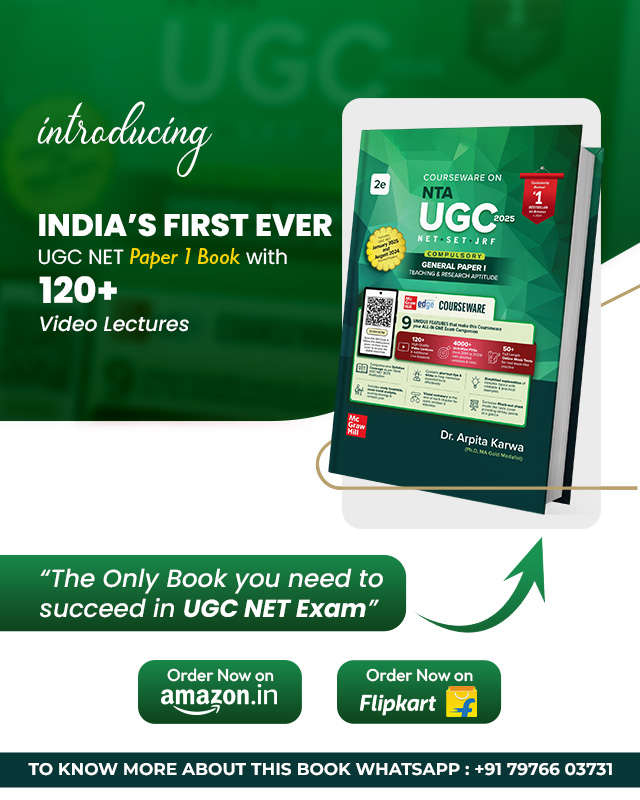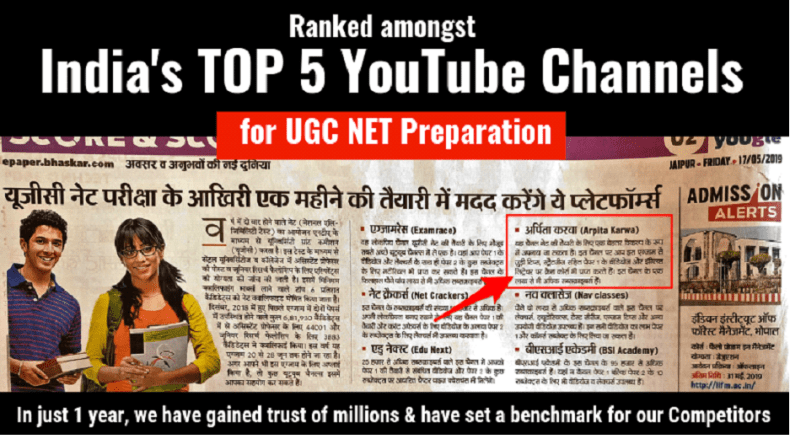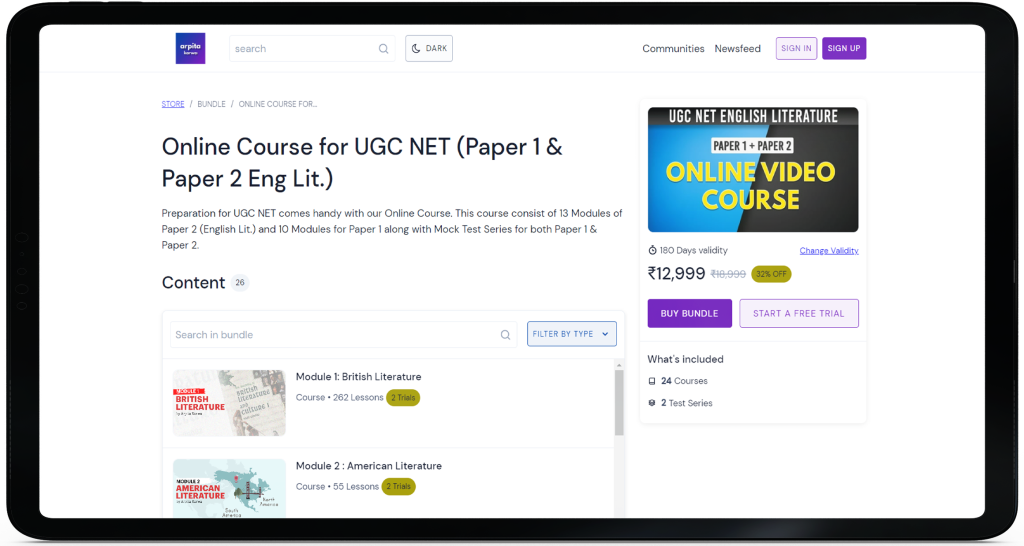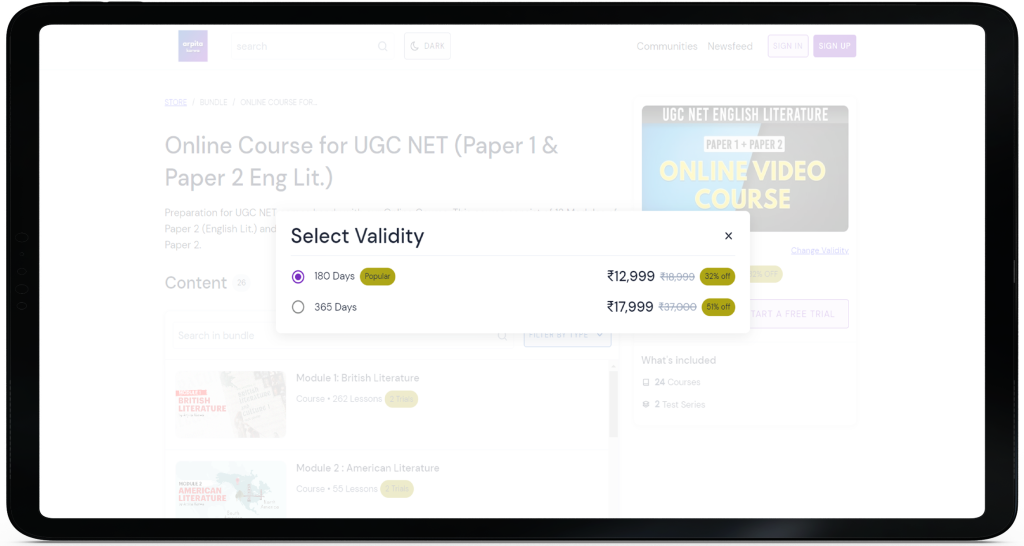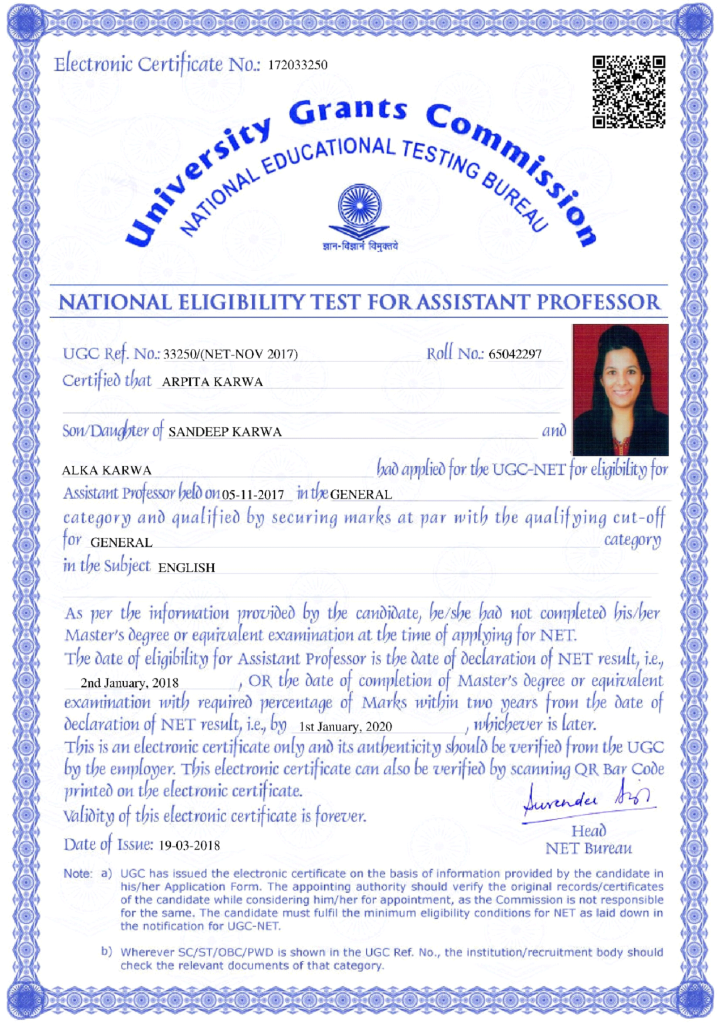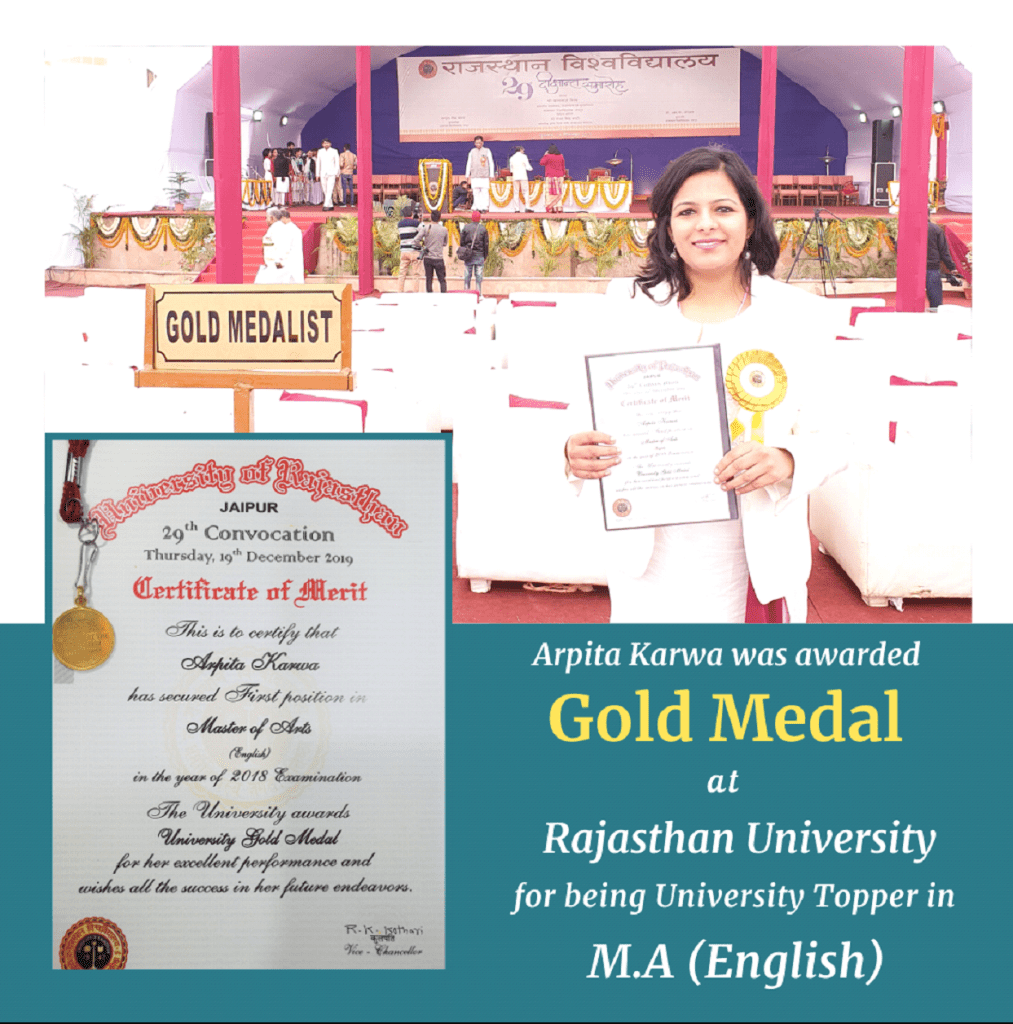14th June 2023 (Paper 2 English Literature) Shift 1
December 7, 2023 2024-06-21 18:4414th June 2023 (Paper 2 English Literature) Shift 1
14th June 2023 (Paper 2 English Literature) Shift 1
UGC NET QUESTION PAPER
14th June 2023 (Shift1)
Paper 2 (English Literature)
Q.1) The full form of MLAT is
1) Modern Language Alertness Test
2) Modern Language Affective Test
3) Modern Language Aptitude Test
4) Modern Language
Answer: 3) Modern Language Aptitude Test
Q.2) Statement I: The book The Life of the Drama was written by Eric Bentley.
Statement II: The book The Life of the Drama highlights the lives of certain seminal twentieth century dramatists.
In the light of the statements given above, choose the correct answer from the options given below:
1) Both Statement I and Statement II are true
2) Both Statement I and Statement II are false
3) Statement I is true but Statement II is false
4) Statement II is true but Statement I is false
Answer: 3) Statement I is true but Statement II is false
Q.3) Match List I with List II
| List I | List II | ||
|---|---|---|---|
| A) | Writing Degree Zero | I | 1957 |
| B) | Mythologies | II | 1953 |
| C) | The Empire of Signs | III | 1973 |
| D) | The Pleasure of the Text | IV | 1970 |
Choose the correct answer from the options given below:
1) A-IV, B-II, C-III, D-I
2) A-III, B-IV. C-II. D-I
3) A-IV, B-III, C-II, D-I
4) A-II, B-I, C-IV, D-III
Answer: 4) A-II, B-I, C-IV, D-III
Q.4) Mention the year in which Political Shakespeare edited by Jonathan Dollimore and Alan Sinfield was published.
1) 1980
2) 1984
3) 1987
4) 1985
Answer: 4) 1985
Q.5) Who among the following has written the play Angels in America?
1) David Mammet
2) August Wilson
3) Sam Shepard
4) Tony Kushner
Answer: 4) Tony Kushner
Q.6) Who, among the following, wrote about Charlotte Brontë that her mind contained ‘nothing but hunger, rebellion, and rage’?
1) Elizabeth Gaskell
2) Matthew Arnold
3) Charles Dickens
4) Mary Shelley
Answer: 2) Matthew Arnold
Q.7) Which three of the following plays have been written by Nissim Ezekiel?
A) Savaksa
B) Marriage-Poem
C). Nalini
D) Mister Behram
E) Sleepwalkers
Choose the correct answer from the options given below:
1) A, B & D
2) B, C & D
3) A, C & D
4) B, C & E
Answer: 4) B, C & E
Q.8) Who proposed the idea that the mind at the time of birth is like a blank slate or tabula rasa?
1) John Locke
2) J S Mill
3) Bertrand Russell
4) Francis Bacon
Answer: 1) John Locke
Q.9) Who among the following is an early Tudor poet?
1) Geoffrey Chaucer
2) John Skelton
3) William Langland
4) John Gower
Answer: 2) John Skelton
Q.10) Which of the following is NOT written by Margaret Atwood?
1) The Edible Woman
2) The Stone Angel
3) Surfacing
4) The Handmaid’s Tale
Answer: 2) The Stone Angel
Q.11) Arrange the correct chronological sequence in which the following texts were published:
A) Tess of the D’Urbervilles
B) Kim
C) The Old Wives’ Tale
D) The Time Machine
E) A Portrait of the Artist as a Young Man
Choose the correct answer from the options given below:
1) A, D, B, C, E
2) D, A, C, B, E
3) B, D, A, C, E
4) A, C, B, E, D
Answer: 1) A, D, B, C, E
Q.12) Who among the following argued that children learn language based on behaviorist reinforcement principles by associating words with meaning?
1) Noam Chomsky
2) B. F. Skinner
3) Stephen Krashen
4) Peter Singer
Answer: 2) B. F. Skinner
Q.13) Which of the following works have been authored by Thomas Carlyle?
A) Chartism
B) Past and Present
C) The French Revolution
D) Suspiria de Profundis
E) The English Mail Coach
Choose the correct answer from the options given below:
1) A, B and C
2) B, C and D
3) A, B and D
4) C, D and E
Answer: 1) A, B and C
Q.14) What does Pierre Bourdieu imply by the term ‘habitus’ in his sociological studies?
1) The culture of increasing consumerization of post-capitalist societies.
2) The phenomenon of the masses succumbing to material fetishism of different types.
3) A person’s posture, speech and the mental habit of perception, classification, appreciation, feeling and action.
4) Personal habits that do not impact the society profoundly.
Answer: 3) A person’s posture, speech and the mental habit of perception, classification, appreciation, feeling and action.
Q.15) Arrange the correct chronological sequence in which the following texts were published:
A) Two Virgins
B) The Painter of Signs
C) Shadow from Ladakh
D) A Bend in the Ganges
E) To Whom She Will
Choose the correct answer from the options given below:
1) A, B, C, D, E
2) D, B, E, C, A
3) E, D, C, A, B
4) C, D, E, A, B
Answer: 3) E, D, C, A, B
Q.16) Which of the following concepts are associated with the writings of Jean Baudrillard?
A) Hyperreality
B) Bricolage
C) Rhizome
D) Simulacra
E) Dispositif
Choose the correct answer from the options given below:
1) A and B
2) A and E
3) C and D
4) A and D
Answer: 4) A and D
Q.17) Arrange the correct chronological sequence of the publication of the following texts:
A) Essay of Dramatic Poesy
B) A Room of One’s Own
C) Culture and Anarchy
D) The Lives of the Poets
E) “Preface to the Lyrical Ballads”
Choose the correct answer from the options given below:
1) A, D, E, C, B
2) D, A, E, B, C
3) A, C, D, E, B
4) E, D, C, A, B
Answer: 1) A, D, E, C, B
Q.18) Match List I with List II
| List I | List II | ||
|---|---|---|---|
| A) | Humayun Kabir | I | A Goddess Named Gold |
| B) | Bhabani Bhattacharya | II | Men and Rivers |
| C) | Manohar Malgonkar | III | Combat of Shadows |
| D) | Kamala Markandaya | IV | Possession |
Choose the correct answer from the options given below:
1) A-IV, B-III, C-I, D-II
2) A-III, B-I, C-IV, D-II
3) A-I, B-II, C-III, D-IV
4) A-II, B-I, C-III, D-IV
Answer: 4) A-II, B-I, C-III, D-IV
Q.19) Which among the following books is NOT written by Edward Said?
1) On Late Style: Music and Literature against the Grain
2) The World, the Text and the Critic
3) Image-Music-Text
4) The Question of Palestine
Answer: 3) Image-Music-Text
Q.20) Donna Haraway’s “Cyborg Manifesto” underscores the notion that –
1) The boundaries between animal, human and machine are breaking down.
2) The cyborgs would establish a dictatorship of the proletariat in the near future.
3) Humans and non-humans would wage a battle for acquisition of cultural capital.
4) Identity politics would be bolstered by intervention of artificial intelligence.
Donna Haraway’s “Cyborg Manifesto” underscores the notion that –
Answer: 1) The boundaries between animal, human and machine are breaking down.
Q.21) Who among of the following are known as Cambridge Critics?
A) Arthur-Quiller Couch
B) F.R. Leavis
C) George Saintsbury
D) I.A. Richards
E) William Empson
Choose the correct answer from the options given below:
1) B, C, and D
2) A, B, and C
3) A, C, and E
4) B, D, and E
Answer: 4) B, D, and E
Q.22) Match List I with List II
| List I | List II | ||
|---|---|---|---|
| A) | The Feast of Youth | I | Meena Kandaswami |
| B) | Hunger | II | P. Lal |
| C) | Writers’ Workshop | III | Harindranath Chatttopadhyaya |
| D) | Touch | IV | Jayanta Mahapatra |
Choose the correct answer from the options given below:
1) (A)-(II), (B)-(III), (C)-(IV), (D)-(I)
2) (A)-(II), (B)-(III), (C)-(I), (D)-(IV)
3) (A)-(III), (B)-(IV), (C)-(II), (D)-(I)
4) (A)-(IV), (B)-(II), (C)-(I), (D)-(III)
Answer: 3) (A)-(III), (B)-(IV), (C)-(II), (D)-(I)
Q.23) Given below are two statements. One is labeled as Assertion A and the other is labeled as Reason R.
Assertion (A): The experience of homosexuality in a homophobic culture is not the same for the whites and blacks.
Reason (R): Sexuality and sexual identity is experienced differently by the whites and blacks.
In the light of the above statements, choose the correct answer from the option given below:
1) Both (A) and (R) are correct and (R) is the correct explanation of (A).
2) Both (A) and (R) are correct but (R) is not the correct explanation of (A).
3) (A) is correct but (R) is not correct.
4) (A) is not correct but (R) is correct.
Answer: 1) Both (A) and (R) are correct and (R) is the correct explanation of (A).
Q.24) Identify the works written by Richard Brinsley Sheridan:
A) Richelieu
B) St Patrick’s Day
C) The Duenna
D) The Citizen of the World
E) Irene
Choose the correct answer from the options given below:
1) A & B
2) C & D
3) B & C
4) A & E
Answer: 3) B & C
Q.25) Match List I with List II
| List I | List II | ||
|---|---|---|---|
| A) | Lions and Shadows | I | W. H. Auden |
| B) | The Still Centre | II | Louis MacNeice |
| C) | Translation of Agamemnon | III | Stephen Spender |
| D) | The Sea and the Mirror | IV | Christopher Isherwood |
Choose the correct answer from the options given below:
1) (A)-(IV), (B)-(III), (C)-(II), (D)-(I)
2) (A)-(II), (B)-(III), (C)-(I), (D)-(IV)
3) (A)-(III), (B)-(II), (C)-(IV), (D)-(I)
4) (A)-(IV), (B)-(II), (C)-(I), (D)-(III)
Answer: 1) (A)-(IV), (B)-(III), (C)-(II), (D)-(I)
Q.26) Match List I with List II
| List I | List II | ||
|---|---|---|---|
| A) | Egotistical Sublime | I | Matthew Arnold |
| B) | Willing Suspension of Disbelief | II | Joseph Addison |
| C) | Touchstone | III | John Keats |
| D) | Pleasures of the Imagination | IV | Samuel Taylor Coleridge |
Choose the correct answer from the options given below:
1) (A)-(III), (B)-(IV), (C)-(I), (D)-(II)
2) (A)-(III), (B)-(IV), (C)-(II), (D)-(I)
3) (A)-(II), (B)-(IV), (C)-(I), (D)-(III)
4) (A)-(II), (B)-(IV), (C)-(I), (D)-(II)
Answer: 1) (A)-(III), (B)-(IV), (C)-(I), (D)-(II)
Q.27) What is the correct chronological sequence of the following texts?
A) “The Advancement of Learning”
B) “An Apologie for Poetry”
C) “The Uses of the Spectator”
D) “My Relations”
E) “How it Strikes a Contemporary”
Choose the correct answer from the options given below:
1) A, B, C, D, E
2) B, A, C, D, E
3) C, A, D, E, B
4) D, C, B. A, E
Answer: 2) B, A, C, D, E
Q.28) The concept of the public sphere plays a particularly important role in the work of
1) Jürgen Habermas
2) Jonathan Dollimore
3) Jean Baudrillard
4) Raymond Williams
Answer: 1) Jürgen Habermas
Q.29) Seven Types of Ambiguity was published in the year
1) 1920
2) 1924
3) 1927
4) 1930
Answer: 4) 1930
Q.30) Match List I with List II
| List I | List II | ||
|---|---|---|---|
| A) | George Meredith | I | The Virginians |
| B) | George Eliot | II | Scenes of Clerical Life |
| C) | Charlotte Brontëe | III | Evan Harrington |
| D) | William Makepeace Thackeray | IV | The Professor |
Choose the correct answer from the options given below:
1) A-III, B-II, C-IV, D-I
2) A-IV, B-III, C-I, D-II
3) A-I, B-II, C-III, D-IV
4) A-II, B-I, C-IV, D-III
Answer: 1) A-III, B-II, C-IV, D-I
Q.31) Match List I with List II
| List I | List II | ||
|---|---|---|---|
| A) | Response to Stephen Gosson | I | Aristotle |
| B) | The Individual Talent | II | Matthew Arnold |
| C) | Catharsis | III | T.S. Eliot |
| D) | Sweetness and Light | IV | Philip Sidney |
Choose the correct answer from the options given below:
1) A-IV. B II, C-III, D-I
2) A-IV, B-III. C-I. D-II
3) A-IV. B III, C-II, D-I
4) A-IV, B-I, C-II. D-III
Answer: 2) A-IV, B-III. C-I. D-II
Q.32) Which of the following fictional works form a trilogy by Mulk Raj Anand?
A) Village
B) Private Life of an Indian Prince
C) Across the Black Waters
D) The Sword and the Sickle
E) The Road
Choose the correct answer from the options given below:
1) A, B and C
2) A, C and D
3) B, D and E
4) C, D and E
Answer: 2) A, C and D
Q.33) The name of the Goddess in Kanthapura is:
1) Kenchamma
2) Akkayya
3) Narsiga
4) Tiruchengode
Answer: 1) Kenchamma
Q.34) Saussure delivered his series of lectures on general linguistics, later published after his death as Course in General Linguistics, at the University of ___________
1) Frankfurt
2) Madrid
3) Geneva
4) Rome
Answer: 3) Geneva
Q.35) Purdah is a collection of poems by Purdah is a collection of poems by
1) Adil Jussawalla
2) Imtiaz Dharker
3) Agha Shahid Ali
4) Sujata Bhatt
Answer: 2) Imtiaz Dharker
Q.36) The Name of the Father’ is a term made famous by
1) Helèné Cixous
2) Jacques Lacan
3) Carl Jung
4) Northrop Frye
Answer: 2) Jacques Lacan
Q.37) The cultural theorist Stuart Hall has written the following:
A) “Encoding/decoding”
B) “The Rediscovery of ‘Ideology: Return of the Repressed in Media Culture and Communication Studies”
C) “The Raw and the Cooked”
D) “What is Digital Humanities?”
E) “Culture Industry”
Choose the correct answer from the options given below:
1) A and B
2) B and C
3) C and D
4) D and E
Answer: 1) A and B
Q.38) Given below are two statements:
Statement 1: Criticism is the construction of a judgment about the negative or positive qualities of someone or something?
Statement 2: Criticism can be theoretical, practical, impressionistic, affective, prescriptive, or descriptive.
In the light of the above statements, choose the correct answer given below:
1) Statement 1 is true but Statement 2 is false.
2) Statement 1 is false but Statement 2 is true.
3) Both Statement 1 and Statement 2 are false
4) Both Statement 1 and Statement 2 are true.
Answer: 4) Both Statement 1 and Statement 2 are true.
Q.39) Noam Chomsky is known for his
1) Generative grammar
2) Glossematics linguistics
3) Linguistic determinism
4) Grammar Translation Method
Answer: 1) Generative grammar
Q.40) Which two of the following plays were written by Ben Jonson?
A) Flowers for Latin Speaking
B) The Devil is an Ass
C) Sapho and Phao
D) The Woman in the Moon
E) The Staple of News
Choose the correct answer from the options given below:
1) A and D
2) A and C
3) B and E
4) D and E
Answer: 3) B and E
Q.41) A structured interview consists of
1) A series of pre-determined questions.
2) A series of pre-determined questions along with questions asked at the time of the interview.
3) A series of questions on the structure of the research.
4) Questions asked at random
Answer: 1) A series of pre-determined questions.
Q.42) Which two of the following dramatists have won the Sultan Padamsee Award?
A) Mahesh Dattani
B) Gurcharan Das
C) Girish Karnad
D) Cyrus Mistry
Choose the correct answer from the options given below:
1) A & C
2) B & D
3) B & C
4) A & D
Answer: 4) A & D
Q.43) The Movement poets included:
A) Donald Davie
B) Hilda Dolittle
C) Michael Longley
D) Philip Larkin
E) Derek Walcott
Choose the correct answer from the options given below:
1) A and E
2) A and D
3) B and E
4) C and D
Answer: 3) B and E
Q.44) Thomas Love Peacock authored the essay
1) “Revolt of the Tartars”
2) “An Essay on the Principles of Human Action”
3) “Four Ages of Poetry”
4) “Seven Lamps of Architecture”
Answer: 3) “Four Ages of Poetry”
Q.45) Who among the following are called Edwardian Novelists?
A) George Eliot
B) Arnold Bennett
C) H. G. Wells
D) Edward Morgan Forster
E) Robert Louis Stevenson
Choose the correct answer from the options given below:
1) A. B and C
2) A. C and D
3) B. C and D
4) B, D and E
Answer: 3) B. C and D
Q.46) “The Love Song of J. Alfred Prufrock” names the following figures:
A) Ezra Pound
B) Michelangelo
C) Valerie Eliot
D) Hamlet
E) Walt Whitman
Choose the correct answer from the options given below:
1) A, C, and E
2) B and D
3) B, D and E
4) D and E
Answer: 2) B and D
Q.47) Match List I with List II
| List I | List II | ||
|---|---|---|---|
| A) | Graham Greene | I | Down and Out in Paris and London |
| B) | Daniel Defoe | II | The Grass is Singing |
| C) | George Orwell | III | A Journal of the Plague Year |
| D) | Doris Lessing | IV | A Sort of Life |
Choose the correct answer from the options given below:
1) (A)-(IV), (B)-(I), (C)-(II), (D)-(III)
2) (A)-(IV), (B)-(III), (C)-(I), (D)-(II)
3) (A)-(II), (B)-(IV), (C)-(I), (D)-(III)
4) (A)-(III). (B)-(IV), (C)-(I), (D)-(II)
Answer: 2) (A)-(IV), (B)-(III), (C)-(I), (D)-(II)
Q.48) Lewis Grassic Gibbon’s A Scots Quair comprises the following books:
A) Sunset Song
B) Brothers and Sisters
C) Cloud Howe
D) Men and Wives
E) Grey Granite
Choose the correct answer from the options given below:
1) A, B and C
2) A, C and E
3) B, C and E
4) C, D and E
Answer: 2) A, C and E
Q.49) Which two of the following plays have been written by Edward Albee?
A) The Zoo Story
B) The price
C) A Delicate Balance
D) Fences
E) Operation Sidewinder
Choose the correct answer from the options given below:
1) A & D
2) B & D
3) A & C
4) B & C
Answer: 3) A & C
Q.50) Thomas Hobbes’s philosophical tract Leviathan was first published in
1) 1631
2) 1641
3) 1651
4) 1661
Answer: 3) 1651
Q.51) What is the correct sequence of the following texts authored by Raymond Williams?
A) The Long Revolution
B) Culture and Society
C) Marxism and Literature
D) Writing in Society
E) The Politics of Modernism
Choose the correct answer from the options given below:
1) A, B, C, D, E
2) B. A, C, D, E
3) C, A, D, E, B
4) D, C, B. A, E
Answer: 2) B. A, C, D, E
Q.52) Who among the following has written Tales of the Grotesque and Arabesque?
1) Herman Melville
2) Nathaniel Hawthorne
3) Mark Twain
4) Edgar Allan Poe
Answer: 4) Edgar Allan Poe
Q.53) Arrange the correct chronological sequence of the publication of the following Indian books of poems:
A) Time to Change
B) Banaras and Other Poems
C) Savitri
D) The Golden Threshold
E) Anthropocene: Climate Change, Contagion, Consolation
Choose the correct answer from the options given below:
1) B. D, E, C, A
2) D, C, A, B, E
3) A, B, C, D, E
4) C, E, B, A, D
Answer: 2) D, C, A, B, E
Q.54) Which of the following works of Milton seeks to adapt the form of Greek tragedy?
1) Samson Agonistes
2) Paradise Regained
3) Lycidas
4) Comus
Answer: 1) Samson Agonistes
Q.55) Who among the following is an Australian Aboriginal poet?
1) Judith Wright
2) Kath Walker
3) Robert Frost
4) Maya Angelou
Answer: 2) Kath Walker
Q.56) The Aesthetics of Thomas Aquinas is written by
1) James Joyce
2) Umberto Eco
3) Walter Pater
4) Matthew Arnold
Answer: 2) Umberto Eco
Q.57) The Kothari Commission suggested
1) That English must be used as a link language to translate one Indian language text into another.
2) That English be studied as a library language with the aim of getting the knowledge of science and technology, commerce and trade by reading standard books in English.
3) That research in India should be done only in English.
4) That a teacher at a University must know how to speak and write in English.
Answer: 2) That English be studied as a library language with the aim of getting the knowledge of science and technology, commerce and trade by reading standard books in English.
Q.58) The author of The Golden Bough, a text that influenced Eliot’s poetry and criticism substantially, is:
1) John Ruskin
2) James George Frazer
3) Thomas Carlyle
4) David Wilson
Answer: 2) James George Frazer
Q.59) Match List I with List II
| List I | List II | ||
|---|---|---|---|
| A) | Practical Criticism | I | John Crowe Ransom |
| B) | The New Criticism | II | F.R. Leavis |
| C) | The Well-Wrought Urn | III | I. A. Richards |
| D) | The Great Tradition | IV | Cleanth Brooks |
Choose the correct answer from the options given below:
1) A-II, B.-I, C-III, DIV
2) A-III, B-I, C-IV, D-II
3) A-III, B-IV, C-II, D-I
4) A-IV. B III, C-II, D-I
Answer: 2) A-III, B-I, C-IV, D-II
Q.60) Arrange the correct chronological sequence of the publication of the following texts:
A) “September 1, 1939”
B) “The Collar”
C) Beppo
D) Paradise Lost
E) Seeing Things
Choose the correct answer from the options given below:
1) B, D, C, A, E
2) B, A, E, C, D
3) A, E, B, C, D
4) C, B, A, D, E
Answer: 1) B, D, C, A, E
Q.61) Arrange the following playwrights chronologically in accordance with the years of their birth.
A) Asif Currimbhoy
B) Gurcharan Das
C) Nissim Ezekiel
D) Gieve Patel
E) Cyrus Mistry
Choose the correct answer from the options given below:
1) A, D, C, B, E
2) E, C, B, D, A
3) C, A, D, B. E
4) C, E, D, A, B
Answer: 3) C, A, D, B. E
Q.62) Given below are two statements:
Statement I: Wordsworth’s “Intimations of Immortality from Recollections of Early Childhood” was published in 1807.
Statement II: In “Intimations of Immortality from Recollections of Early Childhood,” Wordsworth sums up his philosophy of childhood.
In the light of the above statements, choose the correct answer from the options given below:
1) Both Statement I and Statement II are false.
2) Both Statement I and Statement II are true.
3) Statement I is true but Statement II is false.
4) Statement I is false but Statement II is true.
Answer: 2) Both Statement I and Statement II are true.
Q.63) Who among the following was NOT a member of the Beat Generation?
1) Allen Ginsberg
2) Gregory Corso
3) Jack Kerouac
4) Rita Dove
Answer: 4) Rita Dove
Q.64) Facts about the Frankfurt School include the following:
A) It was founded in Frankfurt in 1925.
B) Adorno and Horkheimer were its two members.
C) The School established the term ‘Critical Theory’.
D) It had strong ties with the thinkers of the Moscow Linguistic Circle.
E) It was forced into exile with the ascendency of Nazism in Germany.
Choose the correct answer from the options given below:
1) B, C, and D
2) A, B, and C
3) A, C, and E
4) B, C, and E
Answer: 4) B, C, and E
Q.65) Francis Bacon’s The Advancement of Learning was dedicated to
1) King James I
2) King Henry IV
3) King Richard II
4) Queen Elizabeth I
Answer: 1) King James I
Q.66) Which three of the following plays were written by Sanskrit dramatist Bhasa?
A) Carudatta
B) Ratnavali
C) Urubhanga
D) Malavikagnimitram
E) Karnabharam
Choose the correct answer from the options given below:
1) A. B and D
2) A, C and E
3) B, C and E
4) C, D and E
Answer: 2) A, C and E
Q.67) Some of the following are significant texts of Victorian Criticism. Identify them.
A) Studies in the History of the Renaissance
B) From Rituals to Romance
C) “Hamlet and His Problems”
D) “The Function of Criticism in the Present Time”
E) Modern Painters
Choose the correct answer from the options given below:
1) B, C, and D
2) A, D, and E
3) A, C, and D
4) B, D, and E
Answer: 2) A, D, and E
Q.68) The character who discusses the relative merits of French drama and English drama in Essay of Dramatic Poesy is:
1) Neander
2) Lisideius
3) Crites
4) Eugenius
Answer: 2) Lisideius
Q.69) What is the correct chronological sequence of the following English non-fictional prose writers according to their years of birth?
A) Joseph Addison
B) Francis Bacon
C) Charles Lamb
D) Virginia Woolf
E) Matthew Arnold
Choose the correct answer from the options given below:
1) A, D, C, B, E
2) B, A, C, E, D
3) C, A, D, E, B
4) D, C, B, A, E
Answer: 2) B, A, C, E, D
Q.70) Which among the following is true about Religio Laici?
A) John Dryden wrote Religio Laici.
B) Religio Laici strongly criticized the Anglican Church.
C) Religio Laici means ‘A Layman’s Faith’
D) Religio Laici was published in 1690.
E) Religio Laici was a philosophico-religious prose treatise.
Choose the correct answer from the options given below:
1) A, B and C
2) A and C
3) A and D
4) D and E
Answer: 2) A and C
Q.71) Given below are two statements: One is labelled as Assertion A and the other is labelled as Reason R.
Assertion (A): Scholars working in the field of cultural studies maintain that ‘culture’ in cultural studies is neither aesthetic nor humanist in emphasis, but political.
Reason (R): The implication of the above is that the object of study in cultural studies is ‘high art’ and the study of the exalted literary
canon.
In the light of the above statements, choose the correct answer from the options given below:
1) Both A and R are correct and R is the correct explanation of A.
2) Both A and R are correct, but R is not the correct explanation of A.
3) A is correct but R is not correct.
4) A is not correct but R is correct.
Answer: 3) A is correct but R is not correct.
Q.72) An Account of the Life of Mr Richard Savage, Son of the Earl Rivers (1744) was the first major biography published by
1) Alexander Pope
2) Joseph Addison
3) Samuel Johnson
4) James Boswell
Answer: 3) Samuel Johnson
Q.73) Ted Hughes’ Wodwo is
1) A volume named from the wild men of the woods of Sir Gawain and the Green Knight.
2) A volume named after the elves of the masque of The Tempest.
3) A volume named after the central character of Pearl.
4) A volume named after the name of the monster of Beowulf.
Answer: 1) A volume named from the wild men of the woods of Sir Gawain and the Green Knight.
Q.74) Adam in Adam Bede of George Eliot is a ______________
1) Mason
2) Teacher
3) Carpenter
4) Doctor
Answer: 3) Carpenter
Q.75) Arrange the correct chronological sequence of events that affected literary criticism and theory.
A) Man’s First Flight to the Moon
B) End of the World War II
C) Martin Luther King Jr’s ‘I Have a Dream’ Speech
D) Russian Revolution
E) India’s Independence
Choose the correct answer from the options given below:
1) C, D, E, A, B
2) D, A, E, B, C
3) C, E, B, D, A
4) D, B, E, C, A
Answer: 4) D, B, E, C, A
Q.76) Which of the following works are written by John Dennis?
A) The Advancement and Reformation of Modern Poetry
B) The Christian Hero
C) The Grounds of Criticism in Poetry
D) The Conscious Lovers
E) An Essay on the Genius and Writings of Shakespeare
Choose the correct answer from the options given below:
1) A, B and C
2) A, C and E
3) B, C and D
4) C, D and E
Answer: 2) A, C and E
Q.77) Some of the following terms are integral to New Criticism:
A) Tension
B) Mirror Stage
C) Irony
D) Polyphony
E) Paradox
Choose the correct answer from the options given below:
1) B, C, and D
2) A, B, and C
3) A, C, and E
4) B, D, and E
Answer: 3) A, C, and E
Q.78) The debate on ‘the condition of England question’ was initiated by
1) William Hazlitt
2) Walter Bagehot
3) Thomas Carlyle
4) Matthew Arnold
Answer: 3) Thomas Carlyle
Q.79) Name the book in which Peter Brook makes a study of late 1940s theatre.
1) The Empty Space
2) Experimental Drama
3) After Brecht: British Epic Theatre
4) Around the Absurd: Essays on Modern and Postmodern Drama
Answer: 1) The Empty Space
Q.80) In which novel of Jane Austen is Captain Frederick Wentworth a character?
1) Emma
2) Northanger Abbey
3) Mansfield Park
4) Persuasion
Answer: 4) Persuasion
Q.81) Who among the following built the Red Lion in Stepney in 1567?
1) Richard Burbage
2) James Burbage
3) John Brayne
4) Philip Henslowe
Answer: 3) John Brayne
Q.82) Some of the following poets adorned the Oxford Professor of Poetry Chair:
A) James Fenton
B) Margaret Atwood
C) Seamus Heaney
D) Anne Sexton
E) Paul Muldoon
Choose the correct answer from the options given below:
1) B, C and D
2) A, B and C
3) A, C and E
4) C, D and E
Answer: 3) A, C and E
Q.83) Which of the following methods is used to study the diversity of human cultures in their particular cultural settings?
1) Visual Method of Study.
2) Archival Method of Research.
3) Discourse Analysis.
4) Ethnography
Answer: 4) Ethnography
Q.84) Which of the following playwrights have collaborated in writing the satire Three Hours after Marriage?
A) John Gay
B) John Dryden
C) Alexander Pope
D) William Congreve
E) John Arbuthnot
Choose the correct answer from the options given below:
1) A, B and D
2) A, C and E
3) A, B and E
4) A, D and E
Answer: 2) A, C and E
Q.85) From which novel of Charles Dickens are the following lines extracted?
“I took her hand in mine, and we went out of the ruined place; and, as the morning mists had risen long ago when I first left the forge, so, the evening mists were rising now, and in all the broad expanse of tranquil light they showed to me, I saw no shadow of another parting from her.”
1) Great Expectations
2) David Copperfield
3) Nicholas Nickleby
4) Bleak House
Answer: 1) Great Expectations
Q.86) Match List I with List II
| List I | List II | ||
|---|---|---|---|
| A) | Antonio Gramsci | I | Popular Culture |
| B) | Pierre Bourdieu | II | Hegemony |
| C) | Dick Hebdige | III | Cultural Capital |
| D) | Raymond Williams | IV | Subculture |
Choose the correct answer from the options given below:
1) (A)-(IV), (B)-(I), (C)-(II), (D)-(III)
2) (A)-(II), (B)-(III), (C)-(IV), (D)-(I)
3) (A)-(II), (B)-(IV), (C)-(I), (D)-(III)
4) (A)- (IV), (B)-(III), (C)-(I), (D)-(II)
Answer: 2) (A)-(II), (B)-(III), (C)-(IV), (D)-(I)
Q.87) Which of the following are written by William Faulkner?
A) Sanctuary
B) Color Struck
C) Jesus, The Son of Man
D) Light in August
E) Absalom, Absalom!
Choose the correct answer from the options given below:
1) A, B and C
2) B, C and D
3) A, D and E
4) C, D and E
Answer: 3) A, D and E
Q.88) Which among the following is true about corpus linguistics?
A) It is a collection of naturally occurring spoken and written texts.
B) It has ensured the supremacy of speech over writing.
C) It is about the teaching of linguistics at the school level.
D) It is a methodology that involves computer based empirical analysis of language use.
E) It is a branch of linguistics that is purely based on Chomskyan linguistics.
Choose the correct answer from the options given below:
1) A and B
2) B and C
3) A and D
4) C and E
Answer: 3) A and D
Q.89) A. K. Ramanujan, the famous Indian English poet, was also a
A) Photographer
B) Translator
C) Painter
D) Classical singer
E) Teacher at the University of Chicago
Choose the correct answer from the options given below:
1) A, C and E
2) B, C and D
3) B and D
4) B and E
Answer: 4) B and E
Q.90) Name the play during the performance of which the Globe Theatre was burned down in 1613.
1) Henry VI
2) Henry VIII
3) Richard II
4) Richard III
Answer: 2) Henry VIII
Read the following passage and answer the questions that follow.
Most near, most dear, most loved and most far.
Under the window where I often found her Sitting as huge as Asia, seismic with laughter Gin and chicken helpless in her Irish hand. Irresistible as Rabelais, but most tender for The lame dogs and hurt birds that surround her,- She is a procession no one can follow after But be like a little dog following a brass band.
She will not glance up at the bomber, or condescend
To drop her gin and scuttle to a cellar,
But lean on the mahogany table like a mountain Whom only faith can move, and so I send
O all my faith, and all my love to tell her
That she will move from mourning into mourning.
Q.91) The person described in the poem is sympathetic to
1) Wounded human beings only.
2) Wounded birds only.
3) Disabled dogs and wounded birds.
4) Animals and birds in general.
Answer: 3) Disabled dogs and wounded birds.
Q.92) The person described in the poem is
1) A non-believer.
2) A Christian.
3) A believer.
4) A Marxist
Answer: 3) A believer.
Q.93) The poem uses
1) Cartographic and nature images.
2) Nature images only.
3) Medical images.
4) Astronomical images.
Answer: 1) Cartographic and nature images.
Q.94) The person described in the poem
1) Is alive.
2) Is dead.
3) Is deaf.
4) Will be dead soon.
Answer: 1) Is alive.
Q.95) The third line of the poem suggests something about
1) The complexion of the person.
2) The physique of the person.
3) The nationality of the person.
4) The continent to which she belongs.
Answer: 2) The physique of the person.
Read the following passage and answer the questions that follow:
At school the study of literature can still involve a close reading or ‘practical criticism’ of a novel, play or poem without much or any recourse to external material. Practical criticism is the method of analysing a poem, in isolation from the circumstances of its production, developed by I. A. Richards (1893-1919) in the 1920s. He felt that concentration upon the words on the page’, the technical aspects of the ways verse creates effects, would result in meaningful judgements upon whether a poem was intrinsically ‘good’ or simply reputedly so. The methodology of practical criticism seeks coherence in images, themes and patterns of language. Richards and his colleagues felt that this practice was ‘scientific’ and led to objective value judgements. He was part of a group of lecturers at Cambridge University who played a crucial role in the development of the discipline of English Literature and whose methodology influenced the critical practices of the New Critics, John Crowe Ransom (1888-1974) and Cleanth Brooks (1906-94) and their colleagues in the US. Their ‘scientific’ examination of literature asserted a hierarchy of texts, those that held universal meaning and significance through aesthetic form and those deemed too formulaic to warrant academic scrutiny. The first revered group of texts is often referred to as the literary canon.
Q.96) In the context of the above passage, close reading implies
1) Reading a text by adopting an indisciplinary mode of inquiry.
2) Reading a text by emphasising on its affective capacity.
3) Reading a text by adopting a phenomenological approach.
4) Reading a text by focussing on words and the technical aspects
Answer: 4) Reading a text by focussing on words and the technical aspects
Q.97) The purpose of I.A. Richard’s ‘practical criticism’ was to
1) Ensure that criticism adopted a practical perspective to life and basic human issues.
2) Usher in an objective approach to the study of texts.
3) Valorise the prescriptive function of literature.
4) Foreground the contextual aspects of the text taken under scrutiny.
Answer: 2) Usher in an objective approach to the study of texts.
Q.98) “The methodology of practical criticism seeks coherence in images, themes and patterns of language.”
could be the implication of this statement?
1) Practical criticism involves a political hermeneutic.
2) Practical criticism privileges a pragmatic approach.
3) Practical criticism prioritises on evaluating texts by adopting a purely literary mode of inquiry bereft of contextualization.
4) Practical criticism is activism-based criticism.
Answer: 3) Practical criticism prioritises on evaluating texts by adopting a purely literary mode of inquiry bereft of contextualization.
Q.99) What kind of value judgement did practical criticism as a radical critical movement promote or promulgate?
1) Giving credence to intentionality.
2) Privileging the affective dimension.
3) Valorising historical scholarship.
4) Evaluating value in terms of universal truths.
Answer: 4) Evaluating value in terms of universal truths.
Q.100) In the context of the above passage, what does ‘literary canon’ imply?
1) A selection of random, arbitrary literary works.
2) A selection of Christian exegetical works.
3) A selection of literary texts established as part of a great tradition.
4) A curated selection from popular literature.
Answer: 3) A selection of literary texts established as part of a great tradition.






